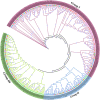Integrated omics and machine learning-assisted profiling of cysteine-rich-receptor-like kinases from three peanut spp . revealed their role in multiple stresses
- PMID: 37799143
- PMCID: PMC10547876
- DOI: 10.3389/fgene.2023.1252020
Integrated omics and machine learning-assisted profiling of cysteine-rich-receptor-like kinases from three peanut spp . revealed their role in multiple stresses
Abstract
Arachis hypogaea (peanut) is a leading oil and protein-providing crop with a major food source in many countries. It is mostly grown in tropical regions and is largely affected by abiotic and biotic stresses. Cysteine-rich receptor-like kinases (CRKs) is a family of transmembrane proteins that play important roles in regulating stress-signaling and defense mechanisms, enabling plants to tolerate stress conditions. However, almost no information is available regarding this gene family in Arachis hypogaea and its progenitors. This study conducts a pangenome-wide investigation of A. hypogaea and its two progenitors, A. duranensis and A. ipaensis CRK genes (AhCRKs, AdCRKs, and AiCRKs). The gene structure, conserved motif patterns, phylogenetic history, chromosomal distribution, and duplication were studied in detail, showing the intraspecies structural conservation and evolutionary patterns. Promoter cis-elements, protein-protein interactions, GO enrichment, and miRNA targets were also predicted, showing their potential functional conservation. Their expression in salt and drought stresses was also comprehensively studied. The CRKs identified were divided into three groups, phylogenetically. The expansion of this gene family in peanuts was caused by both types of duplication: tandem and segmental. Furthermore, positive as well as negative selection pressure directed the duplication process. The peanut CRK genes were also enriched in hormones, light, development, and stress-related elements. MicroRNA (miRNA) also targeted the AhCRK genes, which suggests the regulatory association of miRNAs in the expression of these genes. Transcriptome datasets showed that AhCRKs have varying expression levels under different abiotic stress conditions. Furthermore, the multi-stress responsiveness of the AhCRK genes was evaluated using a machine learning-based method, Random Forest (RF) classifier. The 3D structures of AhCRKs were also predicted. Our study can be utilized in developing a detailed understanding of the stress regulatory mechanisms of the CRK gene family in peanuts and its further studies to improve the genetic makeup of peanuts to thrive better under stress conditions.
Keywords: abiotic stress; gene ontology enrichment; multi-stress-related genes; pangenome-wide; peanut; random forest; receptor-like kinases.
Copyright © 2023 Fatima, Sadaqat, Azeem, Rao, Albekairi, Alshammari and Tahir ul Qamar.
Conflict of interest statement
The authors declare that the research was conducted in the absence of any commercial or financial relationships that could be construed as a potential conflict of interest.
Figures










Similar articles
-
In-silico identification and characterization of O-methyltransferase gene family in peanut (Arachis hypogaea L.) reveals their putative roles in development and stress tolerance.Front Plant Sci. 2023 Mar 31;14:1145624. doi: 10.3389/fpls.2023.1145624. eCollection 2023. Front Plant Sci. 2023. PMID: 37063183 Free PMC article.
-
Genome-wide identification, evolutionary and expression analysis of the cyclin-dependent kinase gene family in peanut.BMC Plant Biol. 2023 Jan 19;23(1):43. doi: 10.1186/s12870-023-04045-w. BMC Plant Biol. 2023. PMID: 36658501 Free PMC article.
-
Genome-wide characterization of phospholipase D family genes in allotetraploid peanut and its diploid progenitors revealed their crucial roles in growth and abiotic stress responses.Front Plant Sci. 2023 Jan 20;14:1102200. doi: 10.3389/fpls.2023.1102200. eCollection 2023. Front Plant Sci. 2023. PMID: 36743478 Free PMC article.
-
The genus Arachis: an excellent resource for studies on differential gene expression for stress tolerance.Front Plant Sci. 2023 Oct 30;14:1275854. doi: 10.3389/fpls.2023.1275854. eCollection 2023. Front Plant Sci. 2023. PMID: 38023864 Free PMC article. Review.
-
Understanding the impacts of drought on peanuts (Arachis hypogaea L.): exploring physio-genetic mechanisms to develop drought-resilient peanut cultivars.Front Genet. 2025 Jan 8;15:1492434. doi: 10.3389/fgene.2024.1492434. eCollection 2024. Front Genet. 2025. PMID: 39845184 Free PMC article. Review.
Cited by
-
Comparative genomics profiling of Citrus species reveals the diversity and disease responsiveness of the GLP pangenes family.BMC Plant Biol. 2025 Mar 27;25(1):388. doi: 10.1186/s12870-025-06397-x. BMC Plant Biol. 2025. PMID: 40140737 Free PMC article.
-
Comparative genomic profiling of CBFs pan-gene family in five yellowhorn cultivars and functional identification of Xg11_CBF11.Front Plant Sci. 2024 Nov 19;15:1481358. doi: 10.3389/fpls.2024.1481358. eCollection 2024. Front Plant Sci. 2024. PMID: 39628536 Free PMC article.
-
Comparative genomics analysis of pheophorbide a oxygenase (PAO) genes in eight pyrus genomes and their regulatory role in multiple stress responses in Chinese pear (Pyrus bretschneideri).Front Genet. 2024 Apr 16;15:1396744. doi: 10.3389/fgene.2024.1396744. eCollection 2024. Front Genet. 2024. PMID: 38689648 Free PMC article.
-
Comparative genomic profiling of transport inhibitor Response1/Auxin signaling F-box (TIR1/AFB) genes in eight Pyrus genomes revealed the intraspecies diversity and stress responsiveness patterns.Front Genet. 2024 May 10;15:1393487. doi: 10.3389/fgene.2024.1393487. eCollection 2024. Front Genet. 2024. PMID: 38798703 Free PMC article.
-
PangenePro: an automated pipeline for rapid identification and classification of gene family members.Bioinform Adv. 2025 Jul 2;5(1):vbaf159. doi: 10.1093/bioadv/vbaf159. eCollection 2025. Bioinform Adv. 2025. PMID: 40655198 Free PMC article.
References
-
- Acharya B. R., Raina S., Maqbool S. B., Jagadeeswaran G., Mosher S. L., Appel H. M., et al. (2007). Overexpression of CRK13, an Arabidopsis cysteine-rich receptor-like kinase, results in enhanced resistance to Pseudomonas syringae. Plant J. 50 (3), 488–499. 10.1111/j.1365-313X.2007.03064.x - DOI - PubMed
LinkOut - more resources
Full Text Sources
Miscellaneous

